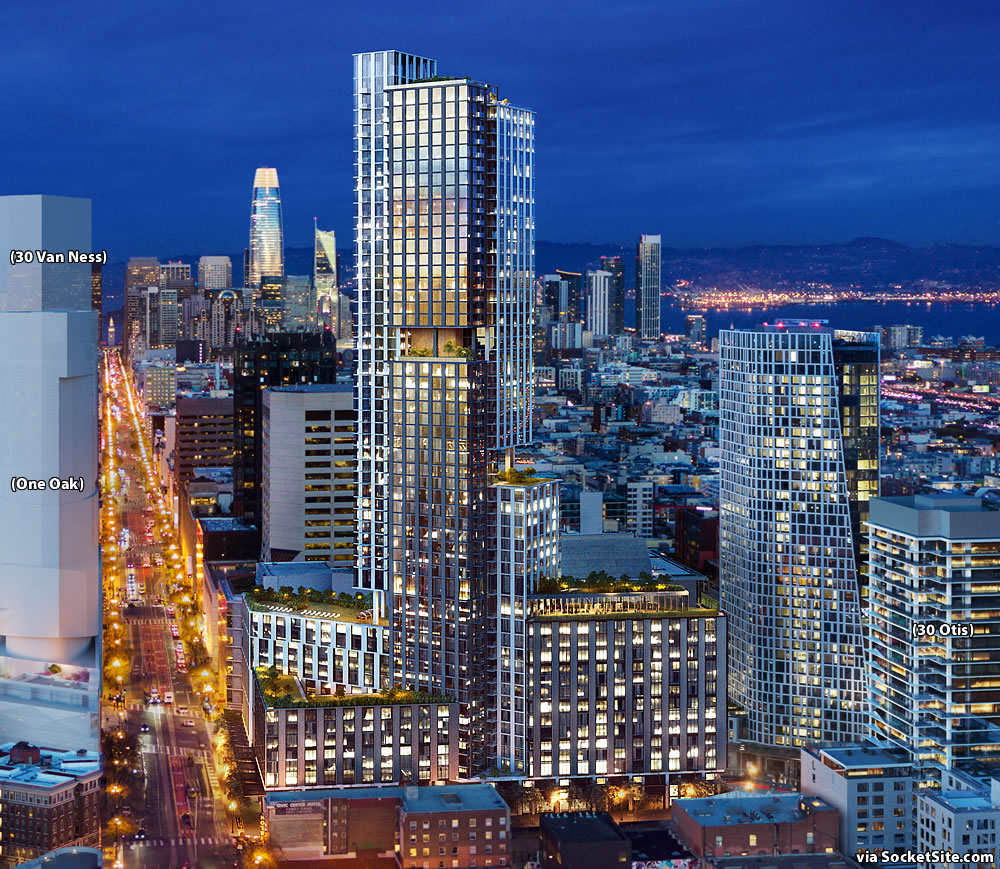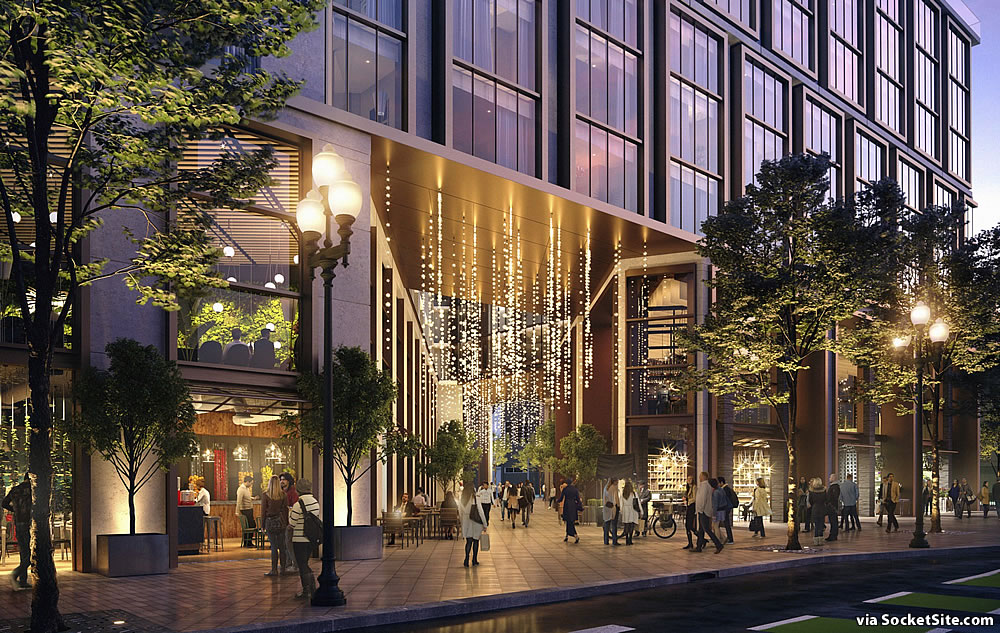Deemed an Environmental Leadership Development Project by Governor Brown back in 2018, which limited the scope and timeline for any EIR-based challenges of the project, the plans for a 55-story tower with nearly 1,000 units of housing to rise up to 590 feet in height on the former San Francisco Honda site at 10 South Van Ness Avenue were approved by Planning two years ago.
While the entitlement for the site came with a standard condition that a site or building permit for the tower be approved and issued within three years of the tower being approved, an application to secure a permit for the project wasn’t submitted to the City until June of this year. At the same time, the project team has just requested that their deadline for securing a permit for the project be pushed back to March of 2026.
In addition to 966 residential units (a mix of 347 studios, 433 one-bedrooms, 165 twos and 21 threes), the Hub District development is slated to yield over 29,400 square feet of new retail and restaurant space, with a basement garage for 261 cars, an enclosed mid-block pedestrian connection between Market and 12th Street, and a new entry to the Van Ness Muni Station, with a new elevator, stair and escalators within the ground floor of the project itself and adjacent to the mid-block alley.
We’ll keep you posted and plugged-in.


How about get rid of parking requirements that make these developments so much more expensive to build, and harder to pencil out, with deep excavation and underground parking structures (costs that are then passed down to the tenants). Not to mention the nuisance of having hundreds of cars coming in and out of what should be a pedestrian friendly area. This is one of the most transit rich areas on the west coast.
I guarantee that a tower like this in this area with zero parking would fill to capacity.
Supersized Development Seeks More Parking, Here’s Why…
That project is in a residential much lower density area. Parking would make more sense in a building lies there and imo is why there is more demand. This is Van Ness and Market, a high density skyscraper zone that sits on top of a subway station and Rapid Bus intersection.
The president of Vanguard Properties uses their own anecdotal experiences to argue units without parking stay on the market longer (I didn’t see any actual scientific data) which may be true for certain neighborhoods and developments (low density vs high density, rental vs condo, etc). But a more thorough data driven analysis needs to be done with data points such as neighborhood, proximity to rapid transit rail vs. a dumpy Muni bus, condo vs rental, proximity to jobs, walkability, crime rate of surrounding area, etc.
Some areas parking makes sense. the main takeaway I got from your link is that residents don’t want to bother with transit and would rather put up with all the aggravations of driving because the transit in sf is very inefficient (and also dangerous imo). Which I don’t disagree with. If the city had better transit infrastructure (not just painted bike lanes), then the marketability of parking-less residential buildings would skyrocket (again imo) And it could save us from massive curb cuts and cars dashing in and out of sidewalks.
How about within a development in an area that’s not only as transit rich but walking distance to more offices as well: Amended Plans for More Parking and a Gated Mid-Block Mews. Keep in mind that car ownership is more highly correlated with income than a lack of transit or bike lanes.
What about incentivizing projects to have zero parking spaces? Perhaps this could be a new Statewide density bonus program that we could get passed.
The spirit of this location is that it’s transit rich and could be made more transit rich with better infrastructure.
Awesome idea. In our city with growing congestion and high rates of pedestrian and cyclist injuries, car ownership (particularly at locations like Market and Van Ness) should be disincentivized.
Car ownership is already discouraged, both de jure (effectively, planning will approve no new commuter parking garages to be built) and de facto (tolerating widespread behavior like this). The problem for transit champions like yourself is that developers only want to construct new housing for people who, due to prevailing values among their target demographic, already own SUVs.
As previously noted, that’s likely due to the fact that car ownership is more highly correlated with income than a lack of transit or bike lanes.
Believe it or not, some people actually need cars. You can’t just get rid of all of the parking. Some elderly aren’t able to use transit and benefit from having a vehicle, especially when accomplishing task as shopping, grocery shopping, and etc. Additionally, families with children that can’t afford to buy a home in the City also benefit from having a car. Having school children at different schools (one elementary and one junior high) and having to BART and muni to two different schools and then subsequently having to BART or Muni to work is alot for a family. Not everyone’s situation is the same, so providing parking in a reduced capacity makes sense and is the logical thing to do…regardless of if the area is transit rich.
Of course, some people need cars and probably well over 50% of residential properties in SF have on-site parking. Paratransit, supermarket shuttles, taxis, ridesharing help those without cars and/or willingness/ability to use transit for shopping. As for families with kids, of course there are situations where having a car makes life easier but there are also many situations where it’s easier, cheaper, and more convenient to get around without one. The more cars and parking spaces added to SF, the less desirable and livable it becomes, particularly for families.
Yeah, the City would love that, but most people in SF, at this income level, still prefer to own a car. Even at $400 per month, [the parking spaces] will all be leased up in no time.
Building this project would potentially encroach on the BART tunnel running underneath. Conventional wisdom has it that the site does not support a highrise structure. Last I remember, a request for approval/review was submitted to BART. Did this ever go through?
I think only Muni has a Van Ness Station. BART goes from Civic Center to 16th & Mission.
The BART tunnel is taking the turn from underneath Market Street to angle into Mission right underneath 10 SVN.
The hand-wringing over this is amusing. We’re seeing right now the consequences of one historic misallocation of capital. In search of ever-elusive profitability, the “tech” sector that is target demo for these digs is downsizing and decamping to cheaper states, and fungible inventory is piling up along Market and in SOMA. So, who’s the target demo? Muni drivers? Cashiers at TJs? Pieds a terre for construction workers from Turlock. Those cohorts all deserve nice lodgings, but I doubt if that’s quite what the developers had in mind.
Other than investors or retired people, the buyers are buying a 2 bedroom or bigger apartment in the city are typically a couple that have a baby or planning to. If you have a baby, and don’t have a car, it is a nightmare. The supermarket runs need a lot more stuff than you can carry with two hands, and imagining carrying a baby troller up and down escalator of muni.
Families with toddlers the world over get along just fine without car ownership, especially in urban environments like Market and Van Ness. On the other hand, streets congested with cars and neighborhoods over run with them can be a nightmare for their residents.
I take it you are largely referring to the developing part of the world. BTW, the same kind of argument was made for the Van Ness BRT. BRT exists in places where they can’t do better. It’s the first thing they get rid off when they can. Japan, China, Europe, you’d get laughed out of the room.
China has BRT and the Van Ness BRT has been a success story, drastically cutting travel time for the Muni and Golden Gate Transit buses (and their riders) that ply this street. Of course, a Van Ness subway would be nice, too.
My comment about families with toddlers getting along fine without having a car referred to cities on all inhabited continents, including our own.
“success” by which metrics? The original plans forced all cross streets into right turns except Hayes and Broadway. “True” BRT and that’s the basis for the runtimes that the project was sold on. Madness of course, so they switched and removed all the forced right turns, which means they won’t make the runtimes.
In another strike of genius, the City approved a tunnel underneath Van Ness to connect the two tracts of CPMC (aka the Jack Tar hospital). Now you’re locked out of underground service for a long stretch b/c you can’t go cut-and-cover construction. So much for “transit rich”…
Replying to Daniel’s latest comment: Van Ness BRT has been a success in markedly reducing travel time – by 35% (and thereby boosting reliability and ridership) along this corridor:
As someone who has been riding buses on Van Ness for about forty years, I assure you the improvement with BRT is phenomenal. What had felt like a slow, long, crowded street with unreliable wait and travel times has become a fast, smooth, short ride. There’s almost too little time to enjoy the experience of zipping past car traffic. Please ride it to see if you haven’t yet done so.
So now we’re down to 7,000 units in the next two years? It took 24 hours for my expectations to start to be realized. Looking forward to more postponed/for sale projects and a softening of construction costs.
That’s incorrect.
As we outlined and is important to understand:
There are still “around 8,000 units which are under construction across the city, units which should be ready for occupancy within the next year or two” and “nearly 11,000 units which have been fully approved, including building permits, but which have yet to break ground.” This project fell somewhere between “building permits in the works” and “yet to be requested.”
I love “a new elevator, stair and escalators within the ground floor of the project itself and adjacent to the mid-block alley.”
I was just looking at the Bart entrance rebuild in front of the Trinity building — what a missed opportunity!
Anyway, hope it eventually happens.
Here’s a revolutionary thought: instead of yet another megamaniacal tower, just build reasonably priced apartments in a 60-foot structure that confirms to local zoning laws and doesn’t attempt to impose the yimby vision on people who don’t want it.
Isn’t this the B of A corner chunk of a building site? An eyesore.
Honda site is accross the Street?
This, 10 South Van Ness, is the Honda site.